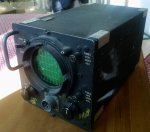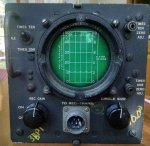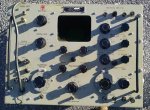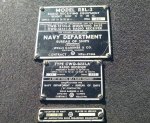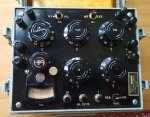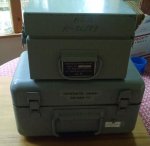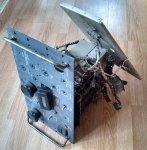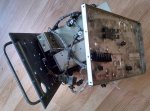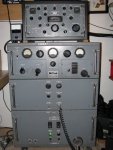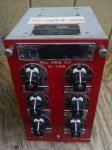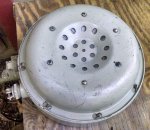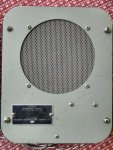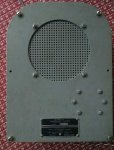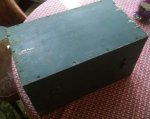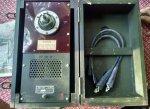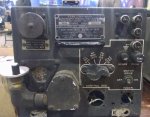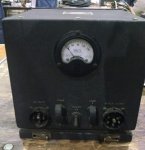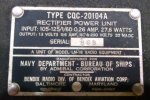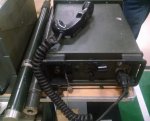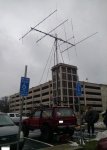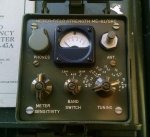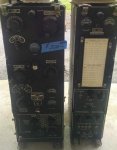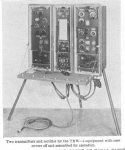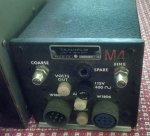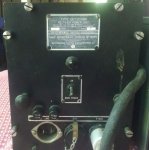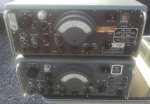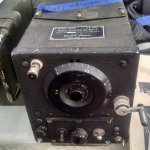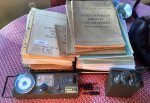-
Steel Soldiers now has a few new forums, read more about it at: New Munitions Forums!
saving military communications gear at hamfests
- Thread starter maddawg308
- Start date

More options
Who Replied?- 1,579
- 556
- 113
- Location
- Greenback, TN
Hey Mike, great report. That RF-301 is a radio I'd like to have sometime, even if they do top out at 15 MHz. It would be fine for a net operation I check into daily on 40m, with no tuning around! Many years ago I bought the antenna tuner, RF-302, and it is a fine tuner. Built extremely well. If the radios were anything comparable they would be built well too.
- 10,883
- 826
- 113
- Location
- Appomattox, VA
Sorry, Ziggy, no dice. If you want me to keep an eye out in the future, let me know, or talk to me about it at Aberdeen....Mike...... Please, please tell me that you have contact info on that civil defense yellow gonset------- I am looking for one for my civil defense jeep!!!!!!
Z
- 10,883
- 826
- 113
- Location
- Appomattox, VA
I went to a small hamfest in Culpeper VA a few weeks back, very few vendors but the good news was they required that the only things brought to sell at the show were radio or electronics-related. I'm getting tired of going to MV shows, hamfests, and gun shows and seeing people selling Beanie Babies, candles, novelty crap, etc. It was just refreshing to see the show organizers sticking to the theme of the show and requiring those who attend to do the same.
Anyways, YAY I BOUGHT SOMETHING! A couple things actually...
Pics 1-4: This was a great purchase, an AN/URM-25D signal generator, a hardened vacuum tube RF sig-gen that produced 10kHz to 50MHz RF output, very sought after by those in the ham radio hobby as they are relatively inexpensive (compared to commercial sig-gens by Tektronix or Agilent). Though, they regularly sell for $250 or so, I picked this up for $25 !! The seller said it worked fine, haven't tried it yet but they are hard to kill. This unit is a "D" model, but packaged in a case marked for a "J" variant. That's not uncommon for the cases to get swapped sometime in their service history. A great buy, made my day!
Pics 5-7: I didn't really have a use for this, but it looked too cool to pass up. Indicator I-152-D, made by Stewart Warner, date is 1955. I believe this was used as an altitude indicator, but I'm not 100% sure. If anyone has used this piece of gear, or knows more about it, please let me know. Cost was $10, worth it just for a display piece.
Anyways, YAY I BOUGHT SOMETHING! A couple things actually...
Pics 1-4: This was a great purchase, an AN/URM-25D signal generator, a hardened vacuum tube RF sig-gen that produced 10kHz to 50MHz RF output, very sought after by those in the ham radio hobby as they are relatively inexpensive (compared to commercial sig-gens by Tektronix or Agilent). Though, they regularly sell for $250 or so, I picked this up for $25 !! The seller said it worked fine, haven't tried it yet but they are hard to kill. This unit is a "D" model, but packaged in a case marked for a "J" variant. That's not uncommon for the cases to get swapped sometime in their service history. A great buy, made my day!
Pics 5-7: I didn't really have a use for this, but it looked too cool to pass up. Indicator I-152-D, made by Stewart Warner, date is 1955. I believe this was used as an altitude indicator, but I'm not 100% sure. If anyone has used this piece of gear, or knows more about it, please let me know. Cost was $10, worth it just for a display piece.
Attachments
-
52.4 KB Views: 8
-
48.7 KB Views: 12
-
37.8 KB Views: 9
-
24.5 KB Views: 9
-
50.3 KB Views: 13
-
89.5 KB Views: 14
-
50.4 KB Views: 11
- 10,883
- 826
- 113
- Location
- Appomattox, VA
Most recent entry in my radio show travels, Harrisburg PA a couple weeks back. Had to hurry at this show, I left the house at 0430 to get there at 0700, and had to leave at 0830 to get back in time for work at 1100. So I drove a total of 5 hours to be at the show for 1-1/2 hours. I am committed. Or I should be committed, I forget what the doctors in the white coats said. Anyways....
Pic 1: AN/USM-50C oscilloscope. Made by Sentinel Electronics. Rack mounted, looks very heavy but very useful. Was already purchased by a show-goer, I took a picture of it as he laid it down to look at something else.
Pic 2-3: A pretty uncommon Wells, Gardner & Co. RBL-3 LF receiver, receives 15-600 KHz. Not very useful for ham use, its well outside the ham bands, it will pick up some interesting submarine radio traffic, and you can get the lower AM broadcast freqs but that's it. Sorry for the glare in the one pic, I was taking it into the sun. $100 was a good price IMHO, but like I've said elsewhere, WWII stuff is not really my cup of tea.
Pic 4: A couple purchases I made of radio test gear at the show, here they are all sealed up and protected.
Pic 5: AN/URM-127 signal generator, generates 20 to 200,000 Hertz output. In really nice shape, missing a few accessories according to the packing list but I think I have a few of them floating around here already. $20 was worth it for a spare siggen.
Pic 6-7: ZM-4B/U resistance bridge, made in 1954. This is a specialized tool used for wire maintenance, from the manual: "Resistance Bridge ZM-4*/U is a portable Wheatstone bridge used to measure the DC resistance of communication and power lines. The measurements are used to determine if a line or cable is faulty and the type and approximate location of the fault. The test set is used also to measure the DC resistance of electrical components and as auxiliary resistance boxes." Might come in handy someday - the instructions are lacquered inside the cover of the unit. Cost was $5 in excellent condition.
Pic 8-9: Who says you can't find good deals on boat anchor radio gear? I bought this Collins R-390A for $20 at the show!
Almost made me cry to see a $500 unit stripped for parts and turned filthy from bad storage. The good news is this former beauty queen had most of the modules, tubes, and easily removable parts removed, but the wiring harness is uncut and the geartrain is intact. It will take a lot of time, cleaning agents, and effort, but I have some spare parts for the R-390A around here so slowly she will be put back in working order.
Pic 1: AN/USM-50C oscilloscope. Made by Sentinel Electronics. Rack mounted, looks very heavy but very useful. Was already purchased by a show-goer, I took a picture of it as he laid it down to look at something else.
Pic 2-3: A pretty uncommon Wells, Gardner & Co. RBL-3 LF receiver, receives 15-600 KHz. Not very useful for ham use, its well outside the ham bands, it will pick up some interesting submarine radio traffic, and you can get the lower AM broadcast freqs but that's it. Sorry for the glare in the one pic, I was taking it into the sun. $100 was a good price IMHO, but like I've said elsewhere, WWII stuff is not really my cup of tea.
Pic 4: A couple purchases I made of radio test gear at the show, here they are all sealed up and protected.
Pic 5: AN/URM-127 signal generator, generates 20 to 200,000 Hertz output. In really nice shape, missing a few accessories according to the packing list but I think I have a few of them floating around here already. $20 was worth it for a spare siggen.
Pic 6-7: ZM-4B/U resistance bridge, made in 1954. This is a specialized tool used for wire maintenance, from the manual: "Resistance Bridge ZM-4*/U is a portable Wheatstone bridge used to measure the DC resistance of communication and power lines. The measurements are used to determine if a line or cable is faulty and the type and approximate location of the fault. The test set is used also to measure the DC resistance of electrical components and as auxiliary resistance boxes." Might come in handy someday - the instructions are lacquered inside the cover of the unit. Cost was $5 in excellent condition.
Pic 8-9: Who says you can't find good deals on boat anchor radio gear? I bought this Collins R-390A for $20 at the show!
Almost made me cry to see a $500 unit stripped for parts and turned filthy from bad storage. The good news is this former beauty queen had most of the modules, tubes, and easily removable parts removed, but the wiring harness is uncut and the geartrain is intact. It will take a lot of time, cleaning agents, and effort, but I have some spare parts for the R-390A around here so slowly she will be put back in working order.
Attachments
-
80.3 KB Views: 7
-
28.3 KB Views: 6
-
97.5 KB Views: 6
-
70.3 KB Views: 4
-
54.5 KB Views: 4
-
40.5 KB Views: 5
-
54.3 KB Views: 8
-
86.5 KB Views: 15
-
66.1 KB Views: 13
Last edited:
- 1,579
- 556
- 113
- Location
- Greenback, TN
Great finds! Those Wheatstone nulling bridges are fun to play with. Good deal on the R390A parts.
Bob wb4ett
Bob wb4ett
Last edited:
Flyingvan911
Well-known member
- 4,709
- 158
- 63
- Location
- Kansas City, MO
You find some good stuff! David KC0ERE
- 10,883
- 826
- 113
- Location
- Appomattox, VA
Went to the Berryville VA hamfest yesterday - I love Berryville, this year it was full to overflowing with vendors and customers, which is a pleasant change from the trend I have been seeing in recent times. It reminds me of the Gilbert PA Military Vehicle show, a nice venue and lots of shade. Met quite a few ham friends, some of who I haven't seen in several years. Great times! And there were LOTS of military radio gear there, took several pics of what was available there, I'll put pics of what I bought in a different post.
Anyways, here's the pics:
Pic 1: Collins-designed R-392 HF receiver, this one was made by Stewart-Warner. Capable of 500 KHz to 32 MHz receiving, so covers all the broadcast band and the HF ham bands. This is a heavy duty radio receiver that is usually paired with the T-195 transmitter, both live up to their "boat anchor" namesakes, they are HEAVY for their size. This unit is essentially a R-390A receiver, that has had its package changed to fit inside a green watertight box for field use, instead of the rack-mounted configuration. Came with a homebrew power supply and a manual, well worth the $250 price tag for one in this nice a shape.
Pic 2: A nice R-1051G radio receiver; these rigs replaced the R-390A for shipboard communications in the 1970s, they were capable of LSB, USB, ISB, RATT, AM, CW, and Standby operation. Made by Stewart-Warner for an original govt. price tag of over $21,000 each !! The "G" and later "H" models are much more rare than the earlier ones like the "B"s that you see often, mainly due to the fact that by the time the Gs and Hs were replaced, the demil requirements for surplus radios went from "sell as is" to "crush with bulldozer". Also, not as many Gs and Hs were made, by this time rack-mounted Harris solid-state receivers were taking over shipboard comms. This unit was for sale in working order for $250, a great deal as well.
Pic 3: A couple items that were interesting, a Wilcox Electric RT-723B/GR VHF transceiver on top, part of the AN/GRC-175 forward observer communications package, capable of transmitting/receiving 110 MHz to 150 MHz. There is very little information online about this rig by itself, other than what I've already told you. The bottom unit is the Stewart-Warner AM-3007/URT radio amplifier. This is part of the AN/WRC-1 radio stack, which includes this amplifier, the R-1051 receiver, and the T-827 transmitter. The amp takes the 1 watt output of the transmitter, bumps it to 100 watts RF out, covers 2-30 MHz operation. Each one of these units was for sale for $200 each, which is a good price.
Pic 4: This was for sale by Howard Mills, a well-respected ham community member and well-known restorer, specializing in Collins radio restorations out of Harpers Ferry, WV. The radio is a Collins R-388/URR, basically a commercial 51J-3. This Korean War-era receiver was capable of HF receiving from 500 KHz to 30.5 MHz. Over 12,000 units were made for the govt. from 1950 to 1962. This rig was completely restored, every last nut and bolt, the caps were replaced and looks better than new! The price tag was $1200 without the cabinet (if you had your own cabinet or rack at home) or $1500 for the radio and the cabinet. It's VERY high for a R-388 receiver, but you can be sure that for your money you are getting a radio restored to H.Mills' level of quality, which is, plug-n-play, better than new. Original commercial price in 1950 was $900 THEN, which is probably about $9,000 in today's dollars, so his price isn't bad when you figure inflation and all the time he has in it.
Pic 5: An ITT/Mackay MSR-8000 HF transceiver, a 125-watt rig capable of 1.6 MHz to 30 MHz operation, on USB, LSB, AM, CW, and FSK (frequency shift keying, otherwise known as RTTY). Never seen one before, this was an interesting radio. $500 seems fair for what it is capable of.
Pic 6: A BC-221 Signal Corps frequency meter. This is basically a poor-mans signal generator. WWII era, they came in either a wood green-painted cabinet like this, or black wrinkle paint steel cabinet. This was advertised as $20 with headphones and a power supply, a steal if it worked. I would've bought it but I have a couple already. NOTE TO PROSPECTIVE BUYERS OF BC-221s !!! - note the access door on the front that says "CALIBRATION BOOK INSIDE". If you are ever in the market for one of these, check to see that it's in there, and the serial number on the book matches that on the freq. meter - if the serial number doesn't match or the book is missing, the freq. meter is pretty much useless. The calibration books are UNIQUE to each and every one of the BC-221s ever made, based upon the performance of the individual parts inside when it was built. They are not interchangable between other BC-221s.
Pics 7-8: First pic is a drawer RF deck for the Barker & Williamson T-368/URT transmitter - this is a heckuva unit, weighing in at 700 pounds, is about 41 inches cubed, capable of continuous 450-watt output. Covers AM, CW, and RTTY operation, from 1.6 to 20 MHz. This is a well-made unit, and finding a complete one will set you back $1200 to $1500, not to mention you need a forklift to move it, and your hamshack better not be on the second floor, or this will soon be in the basement. First pic is of the drawer that was for sale (a good price for spares, but I'll probably never own one), the 2nd pic is of a complete T-368/URT unit.
Pic 9: Another unit I have never seen before - a Sunair Electronics RT-1277 transceiver, part of the URC-92 system. 125 watts out, capable of AM, CW, LSB, and USB over 1.6 to 30 MHz. Looks like an early digital unit of the 1970s and 1980s. This was sold without the mic, for $875. I don't know enough about this unit to say whether that was a good price or not.
Next post: my saves! Stay tuned...
Anyways, here's the pics:
Pic 1: Collins-designed R-392 HF receiver, this one was made by Stewart-Warner. Capable of 500 KHz to 32 MHz receiving, so covers all the broadcast band and the HF ham bands. This is a heavy duty radio receiver that is usually paired with the T-195 transmitter, both live up to their "boat anchor" namesakes, they are HEAVY for their size. This unit is essentially a R-390A receiver, that has had its package changed to fit inside a green watertight box for field use, instead of the rack-mounted configuration. Came with a homebrew power supply and a manual, well worth the $250 price tag for one in this nice a shape.
Pic 2: A nice R-1051G radio receiver; these rigs replaced the R-390A for shipboard communications in the 1970s, they were capable of LSB, USB, ISB, RATT, AM, CW, and Standby operation. Made by Stewart-Warner for an original govt. price tag of over $21,000 each !! The "G" and later "H" models are much more rare than the earlier ones like the "B"s that you see often, mainly due to the fact that by the time the Gs and Hs were replaced, the demil requirements for surplus radios went from "sell as is" to "crush with bulldozer". Also, not as many Gs and Hs were made, by this time rack-mounted Harris solid-state receivers were taking over shipboard comms. This unit was for sale in working order for $250, a great deal as well.
Pic 3: A couple items that were interesting, a Wilcox Electric RT-723B/GR VHF transceiver on top, part of the AN/GRC-175 forward observer communications package, capable of transmitting/receiving 110 MHz to 150 MHz. There is very little information online about this rig by itself, other than what I've already told you. The bottom unit is the Stewart-Warner AM-3007/URT radio amplifier. This is part of the AN/WRC-1 radio stack, which includes this amplifier, the R-1051 receiver, and the T-827 transmitter. The amp takes the 1 watt output of the transmitter, bumps it to 100 watts RF out, covers 2-30 MHz operation. Each one of these units was for sale for $200 each, which is a good price.
Pic 4: This was for sale by Howard Mills, a well-respected ham community member and well-known restorer, specializing in Collins radio restorations out of Harpers Ferry, WV. The radio is a Collins R-388/URR, basically a commercial 51J-3. This Korean War-era receiver was capable of HF receiving from 500 KHz to 30.5 MHz. Over 12,000 units were made for the govt. from 1950 to 1962. This rig was completely restored, every last nut and bolt, the caps were replaced and looks better than new! The price tag was $1200 without the cabinet (if you had your own cabinet or rack at home) or $1500 for the radio and the cabinet. It's VERY high for a R-388 receiver, but you can be sure that for your money you are getting a radio restored to H.Mills' level of quality, which is, plug-n-play, better than new. Original commercial price in 1950 was $900 THEN, which is probably about $9,000 in today's dollars, so his price isn't bad when you figure inflation and all the time he has in it.
Pic 5: An ITT/Mackay MSR-8000 HF transceiver, a 125-watt rig capable of 1.6 MHz to 30 MHz operation, on USB, LSB, AM, CW, and FSK (frequency shift keying, otherwise known as RTTY). Never seen one before, this was an interesting radio. $500 seems fair for what it is capable of.
Pic 6: A BC-221 Signal Corps frequency meter. This is basically a poor-mans signal generator. WWII era, they came in either a wood green-painted cabinet like this, or black wrinkle paint steel cabinet. This was advertised as $20 with headphones and a power supply, a steal if it worked. I would've bought it but I have a couple already. NOTE TO PROSPECTIVE BUYERS OF BC-221s !!! - note the access door on the front that says "CALIBRATION BOOK INSIDE". If you are ever in the market for one of these, check to see that it's in there, and the serial number on the book matches that on the freq. meter - if the serial number doesn't match or the book is missing, the freq. meter is pretty much useless. The calibration books are UNIQUE to each and every one of the BC-221s ever made, based upon the performance of the individual parts inside when it was built. They are not interchangable between other BC-221s.
Pics 7-8: First pic is a drawer RF deck for the Barker & Williamson T-368/URT transmitter - this is a heckuva unit, weighing in at 700 pounds, is about 41 inches cubed, capable of continuous 450-watt output. Covers AM, CW, and RTTY operation, from 1.6 to 20 MHz. This is a well-made unit, and finding a complete one will set you back $1200 to $1500, not to mention you need a forklift to move it, and your hamshack better not be on the second floor, or this will soon be in the basement. First pic is of the drawer that was for sale (a good price for spares, but I'll probably never own one), the 2nd pic is of a complete T-368/URT unit.
Pic 9: Another unit I have never seen before - a Sunair Electronics RT-1277 transceiver, part of the URC-92 system. 125 watts out, capable of AM, CW, LSB, and USB over 1.6 to 30 MHz. Looks like an early digital unit of the 1970s and 1980s. This was sold without the mic, for $875. I don't know enough about this unit to say whether that was a good price or not.
Next post: my saves! Stay tuned...
Attachments
-
52.4 KB Views: 18
-
43.6 KB Views: 18
-
50 KB Views: 19
-
44.3 KB Views: 19
-
37.6 KB Views: 18
-
37.2 KB Views: 14
-
60.7 KB Views: 16
-
63.5 KB Views: 17
-
42.4 KB Views: 16
m38inmaine
Well-known member
- 2,145
- 103
- 63
- Location
- Maine USA
Any contact info on the MSR-8000?, I have one of those Sunair radio's they are a nice rig.
- 10,883
- 826
- 113
- Location
- Appomattox, VA
I didn't buy the R-392. A lot of the radios I have taken pictures of in this thread were ones I saw at the show, and posted here as a gallery of what military radio equipment can be found at ham radio shows, a little about the rigs themselves, and the prices I have seen on them. A few of the pics I have taken show what I did buy, I captioned them as such.Hey Mike if you decide to sell the Collins 392 let me know or maybe you could bring it with you and make a trip to my place...your trailer will definitely not be empty when you leave!!
Sorry, I didn't get the seller's information.Any contact info on the MSR-8000?, I have one of those Sunair radio's they are a nice rig.
- 14,325
- 1,945
- 113
- Location
- Dayton, OH
This year was my first ever Hamvention in Dayton and it will be the last. They are moving it because Hara Arena is closing its doors in 3 weeks. 
They had quite a bit of military gear this year. It is moving to the Greene County Fairgrounds and Convention Center in Xenia OH which I have been to for a truck pull but wasn't real fond of the place.
It was 6 miles to Hara and now it will be about 18.......
They had quite a bit of military gear this year. It is moving to the Greene County Fairgrounds and Convention Center in Xenia OH which I have been to for a truck pull but wasn't real fond of the place.
It was 6 miles to Hara and now it will be about 18.......
- 10,883
- 826
- 113
- Location
- Appomattox, VA
Okay, FINALLY! I have a chance to post pics of what I did pick up at the last hamfest, some of these units are keepers, the rest will be resold to make more $$$ to purchase other things I need more. Here goes:
Pic 1: SA-1794/UG teletype switching unit - essentially a switch box, meant for secure teletype installations. Not sure what I have in mind for it for the future, but it was cheap (can't remember exactly how much) and I have never owned a piece of secure commo gear before, even a switch box.
Pic 2: another FSK Teletype unit, a CV-57/URR FSK demodulator. $20 out the door, yet another "not sure what I'm going to do with it, but it looks cool". Classic 1950s architecture. I guess if I ever get into teletype in the future, this might be handy. Excellent condition inside and out.
Pic 3: I bought a few Navy speakers at the hamfest, this one is heavy, looks like a landmine and weighs about the same. I believe these were made by RCA, but there is no tag anywhere on it. $20 for it.
Pic 4: Another speaker, LS-305B/SIC. This one is a lot lighter then the previous one, made of aluminum. $20 as well, I think this one I'm going to keep and convert it for use as a radio speaker.
Pic 5: Yet ANOTHER speaker, LS-530/SIC, another $20 as well. Similar in size and weight of the previous one. And probably another to convert to a radio speaker.
Pic 6-7: I have this disease, please help me. Anytime I see WWII ARC-5 units for cheap at a hamfest I'm saving them. Most of the ones I save are hacked from decades of ham operators converting them to do whatever they can make from them. I have about 25 or so, from junk to pristine originals, waiting for my retirement years and I can put them back together the way they originally were. This lot of 9 ARC-5 transmitters I got at the Berryville hamfest, from various sellers, total was $60 for all of them. I missed out on a 2-radio aircraft mount for $10 from one seller, by the time I looked back around it was gone! That would've been a neat save.
Pic 8-10: Dummy load TS-279/UPM. It cost me $15 in VG condition in the wooden case. Dated January 1950. The internet doesn't have much in the way of information on it, so I have to play with it to find out its capabilities. Not often you find vintage military electronics in the original wooden case with a dessicant pack in it as well!
Pic 1: SA-1794/UG teletype switching unit - essentially a switch box, meant for secure teletype installations. Not sure what I have in mind for it for the future, but it was cheap (can't remember exactly how much) and I have never owned a piece of secure commo gear before, even a switch box.
Pic 2: another FSK Teletype unit, a CV-57/URR FSK demodulator. $20 out the door, yet another "not sure what I'm going to do with it, but it looks cool". Classic 1950s architecture. I guess if I ever get into teletype in the future, this might be handy. Excellent condition inside and out.
Pic 3: I bought a few Navy speakers at the hamfest, this one is heavy, looks like a landmine and weighs about the same. I believe these were made by RCA, but there is no tag anywhere on it. $20 for it.
Pic 4: Another speaker, LS-305B/SIC. This one is a lot lighter then the previous one, made of aluminum. $20 as well, I think this one I'm going to keep and convert it for use as a radio speaker.
Pic 5: Yet ANOTHER speaker, LS-530/SIC, another $20 as well. Similar in size and weight of the previous one. And probably another to convert to a radio speaker.
Pic 6-7: I have this disease, please help me. Anytime I see WWII ARC-5 units for cheap at a hamfest I'm saving them. Most of the ones I save are hacked from decades of ham operators converting them to do whatever they can make from them. I have about 25 or so, from junk to pristine originals, waiting for my retirement years and I can put them back together the way they originally were. This lot of 9 ARC-5 transmitters I got at the Berryville hamfest, from various sellers, total was $60 for all of them. I missed out on a 2-radio aircraft mount for $10 from one seller, by the time I looked back around it was gone! That would've been a neat save.
Pic 8-10: Dummy load TS-279/UPM. It cost me $15 in VG condition in the wooden case. Dated January 1950. The internet doesn't have much in the way of information on it, so I have to play with it to find out its capabilities. Not often you find vintage military electronics in the original wooden case with a dessicant pack in it as well!
Attachments
-
53.4 KB Views: 12
-
32.5 KB Views: 8
-
66.9 KB Views: 7
-
80.2 KB Views: 7
-
64.2 KB Views: 13
-
62.1 KB Views: 7
-
56 KB Views: 9
-
49.6 KB Views: 8
-
63.4 KB Views: 9
-
35.8 KB Views: 9
- 10,883
- 826
- 113
- Location
- Appomattox, VA
Again, been a while since I updated this thread, heck it's been a while since I could spend any time on this site period. Life's been handing me some curveballs which have eaten up my time and energy, but I've still been going to the hamfests. Here's some of the military gear I've seen in recent months.
Show: Richmond VA "Frostfest", Feb. 4th, 2017 - Always a big show, always inside. I was a little disappointed this year, there wasn't much in the way of vintage radio equipment there, compared to previous years. But there are always a couple pieces which piqued my interest, none of which I purchased but perhaps they will make you smile anyways.
Pic 1: Collins R-388, I believed I talked about this model previously. It's a rack mount HF radio, the listed price of $300 was more than fair for a working example. I was really interested in the case it was mounted in - looked like thick fiberglass and able to take a beating. Would be the perfect thing for ARRL field day, I'd be the only guy out there with a rack-mounted boat anchor radio outside listening to other contesters.
Pic 2: Collins-made R-390 (no "A"), being wheeled around the convention on a handtruck by the buyer. I didn't ask the price he paid. What got my attention was the interesting front panel, which looks like an original tan colored paint job. Any paint job other than Navy grey is very uncommon, and I don't think this was a repaint, it was too complete and looked worn, but factory applied.
Pic 3: CRV-46151, otherwise known as the ARB aircraft radio from WWII. From the net: "he ARB is a World War II US Navy aircraft radio receiver system. The Navy identifies the receiver as part number CRV-46151. Frequency coverage is continuous from 195 KHz to 9.05 MHz in 4 bands. The manufacturer was RCA." This unit I believe was for sale for $15 or $20, missing a few parts as shown in the pic. Probably still worth it.
Pic 4-5: This is one of those few times I get stumped and later I have a "dammit" moment when I realize I needed something I missed. This is a CQC-20104A rectifier power unit. Doesn't ring a bell in my mind, there's a million pieces of radio and electronic stuff from WWII that was used in all sorts of things, some are common, some rare. Since it didn't register, I didn't give it two thoughts as to needing it. When I got home, I saw the fine print in the data plate pic which says "A unit of model LM-18 radio equipment". The LM-18 is a small, lunchbox-sized frequency source used to calibrate other radio equipment. I have two of them, with no power source. This CQC box, is the power source. Dammit, I should've bought it for $10.
Pic 6-7: Collins 18S-4 receiver-transmitter, 2-18 MHz operation, 100W output, AM/CW on 10 channels. Unit is big as an ox and weighs as much. I can't remember the price, sorry. Looks to be vintage 1950s or early 1960s vintage.
More to come!
Show: Richmond VA "Frostfest", Feb. 4th, 2017 - Always a big show, always inside. I was a little disappointed this year, there wasn't much in the way of vintage radio equipment there, compared to previous years. But there are always a couple pieces which piqued my interest, none of which I purchased but perhaps they will make you smile anyways.
Pic 1: Collins R-388, I believed I talked about this model previously. It's a rack mount HF radio, the listed price of $300 was more than fair for a working example. I was really interested in the case it was mounted in - looked like thick fiberglass and able to take a beating. Would be the perfect thing for ARRL field day, I'd be the only guy out there with a rack-mounted boat anchor radio outside listening to other contesters.
Pic 2: Collins-made R-390 (no "A"), being wheeled around the convention on a handtruck by the buyer. I didn't ask the price he paid. What got my attention was the interesting front panel, which looks like an original tan colored paint job. Any paint job other than Navy grey is very uncommon, and I don't think this was a repaint, it was too complete and looked worn, but factory applied.
Pic 3: CRV-46151, otherwise known as the ARB aircraft radio from WWII. From the net: "he ARB is a World War II US Navy aircraft radio receiver system. The Navy identifies the receiver as part number CRV-46151. Frequency coverage is continuous from 195 KHz to 9.05 MHz in 4 bands. The manufacturer was RCA." This unit I believe was for sale for $15 or $20, missing a few parts as shown in the pic. Probably still worth it.
Pic 4-5: This is one of those few times I get stumped and later I have a "dammit" moment when I realize I needed something I missed. This is a CQC-20104A rectifier power unit. Doesn't ring a bell in my mind, there's a million pieces of radio and electronic stuff from WWII that was used in all sorts of things, some are common, some rare. Since it didn't register, I didn't give it two thoughts as to needing it. When I got home, I saw the fine print in the data plate pic which says "A unit of model LM-18 radio equipment". The LM-18 is a small, lunchbox-sized frequency source used to calibrate other radio equipment. I have two of them, with no power source. This CQC box, is the power source. Dammit, I should've bought it for $10.
Pic 6-7: Collins 18S-4 receiver-transmitter, 2-18 MHz operation, 100W output, AM/CW on 10 channels. Unit is big as an ox and weighs as much. I can't remember the price, sorry. Looks to be vintage 1950s or early 1960s vintage.
More to come!
Attachments
-
82.7 KB Views: 8
-
48 KB Views: 10
-
91.6 KB Views: 9
-
51.4 KB Views: 8
-
75.8 KB Views: 8
-
48.1 KB Views: 9
-
43.5 KB Views: 8
Last edited:
- 10,883
- 826
- 113
- Location
- Appomattox, VA
NEXT SHOW!
Annandale VA - sometime in March 2017 (forget the exact date) - it's never March in VA without cold rain. This is an indoor/outdoor show at a community college, the outdoor part of it was killed by crappy weather.
Pic 1: Pair of Warsaw Pact field radios, the left one is an East German R-323, the right is a Soviet R-326. The -323 is a VHF rig, 20-100 MHz, the -326 is HF 1-20 MHz. Very rare in this country, either one. The seller was selling these as a package, with a pile of accessories, I believe for $200 for everything.
Pic 2: AN/PRC-41 rig, the PRC-41 is a lightweight, portable VHF/ultra high frequency (UHF)-AM receiver-transmitter which permits manpack, fixed-station, or vehicular operation, from 225 to 400 MHz. This unit came with a handset, the vehicular mount (hard to find!), and three antenna components (2 of the cylindrical masts, and 1 Yagi mast without the Yagi elements). The inside of this unit was as good as the day it was made. Sale price was very fair, I bought it because I knew of an interested gentleman who needed one.
Pic 3-4: A very uncommon R-1490/GRR-17 radio receiver, this is the last radio produced by the National Radio Company before they went belly-up. From what I've found online, it's an EXTREMELY well made receiver, the best NRC made, probably killed them for the cost investment of development. Operation is 2-30 MHz, tuning looks to be similar to R-1051 Navy radio units, or GRC-106, in other words, you'll get carpal tunnel changing the tuning knobs. This unit wasn't for sale, only for display.
Pic 5-7: nothing military radio related - just something cool in the parking lot, someone went to a LOT of fabwork trouble to created a full body roll cage for offroading, plus made a mobile antenna mount for multi-band operation. Thought you'd enjoy.
Pic 8: ME-61/GRC field strength meter, this one is meant for 1.5 to 24 MHz operation. Was meant to be paired with the AN/GRC-9, or the AN/GRC-19 set. This one was in brand new condition, for $50. I offered $30 and the seller took it. Will be a valued piece of test gear for the collection.
Pic 9: the saves I bought at the show: the PRC-41 set, which has found a new home with SS member Storm51 (thanks Storm!), the ME-61 field strength meter, and a military manual on an unrelated piece of equipment I don't yet have for $1.
Annandale VA - sometime in March 2017 (forget the exact date) - it's never March in VA without cold rain. This is an indoor/outdoor show at a community college, the outdoor part of it was killed by crappy weather.
Pic 1: Pair of Warsaw Pact field radios, the left one is an East German R-323, the right is a Soviet R-326. The -323 is a VHF rig, 20-100 MHz, the -326 is HF 1-20 MHz. Very rare in this country, either one. The seller was selling these as a package, with a pile of accessories, I believe for $200 for everything.
Pic 2: AN/PRC-41 rig, the PRC-41 is a lightweight, portable VHF/ultra high frequency (UHF)-AM receiver-transmitter which permits manpack, fixed-station, or vehicular operation, from 225 to 400 MHz. This unit came with a handset, the vehicular mount (hard to find!), and three antenna components (2 of the cylindrical masts, and 1 Yagi mast without the Yagi elements). The inside of this unit was as good as the day it was made. Sale price was very fair, I bought it because I knew of an interested gentleman who needed one.
Pic 3-4: A very uncommon R-1490/GRR-17 radio receiver, this is the last radio produced by the National Radio Company before they went belly-up. From what I've found online, it's an EXTREMELY well made receiver, the best NRC made, probably killed them for the cost investment of development. Operation is 2-30 MHz, tuning looks to be similar to R-1051 Navy radio units, or GRC-106, in other words, you'll get carpal tunnel changing the tuning knobs. This unit wasn't for sale, only for display.
Pic 5-7: nothing military radio related - just something cool in the parking lot, someone went to a LOT of fabwork trouble to created a full body roll cage for offroading, plus made a mobile antenna mount for multi-band operation. Thought you'd enjoy.
Pic 8: ME-61/GRC field strength meter, this one is meant for 1.5 to 24 MHz operation. Was meant to be paired with the AN/GRC-9, or the AN/GRC-19 set. This one was in brand new condition, for $50. I offered $30 and the seller took it. Will be a valued piece of test gear for the collection.
Pic 9: the saves I bought at the show: the PRC-41 set, which has found a new home with SS member Storm51 (thanks Storm!), the ME-61 field strength meter, and a military manual on an unrelated piece of equipment I don't yet have for $1.
Attachments
-
65.9 KB Views: 14
-
62.4 KB Views: 14
-
54.8 KB Views: 17
-
52 KB Views: 13
-
43.7 KB Views: 16
-
98.1 KB Views: 15
-
31.7 KB Views: 16
-
74 KB Views: 22
-
95.5 KB Views: 26
Last edited:
- 888
- 9
- 0
- Location
- Seattle, WA
Thanks again for picking up the PRC-41, Maddawg! Now I just have to find the front data plate and markings or labels for the front panel. That ME-61/GRC is also a very nice little unit that would go well with my GRC-19's (if you ever want to sell it).
Please keep me in mind for other GRC-19 items (especially meters and knobs). I'd even be interested in whole units (either T-195's or R-392's).
Thanks again!
Please keep me in mind for other GRC-19 items (especially meters and knobs). I'd even be interested in whole units (either T-195's or R-392's).
Thanks again!
- 10,883
- 826
- 113
- Location
- Appomattox, VA
Last one for a little while - until the next show!
Hagerstown MD, May 6th, 2017 - overcast day with a few showers, but the good news is this show is under a pole barn. It's a small show, but a few goodies always seem to show up.
Pic 1-6: definitely not something I would've expected to see at this show. This is the early WWII TBW series of ship-to-shore "portable" (by a forklift!) MF and HF radios, covering 350-1000 KHz, and 3-18.1 MHz AM. Powered by a gasoline generator. The last pic shows what it would look like if complete, what is for sale is only 2 of the 3 units, missing the power supply module and the wooden case with legs. Excellent condition for its age, I'm sure it was worth the $200 price tag, but then you'd have to find the rest of the package.
Pic 7-10: Items I saved at the hamfest include:
CAY-46076-A radio receiver, part of the WWII RBM-5 radio set, made by Westinghouse. The radio covers the medium freq. bands of 200 to 2000 KHz, requires headsets (I gotta dig up a set matched for this radio). In very nice shape, in and out, but the real prize is the original CCT-20086 rectifier power unit that came with it, including a nice condition original power cord, these two are the RARE pieces that are not often found with the receiver. Total price was $45. This will be a neat thing to try and get working!
CN-116/APG-30 voltage regulator for AN/APG-30 series of X-band aircraft fire control radars. Thought it was more communications related but not so much. Made by Sperry Corp. for installation in the B-45 Tornado, Boeing B-47, F-86 Sabre fighter jets, the F-100 Super Sabre, Republic F-84 Thunderjet, the F-8 Crusader, and the F-4 Phantom II. For $5, it was worth it to save, but it will probably end up on eBay since I have no interest in building a radar set.
Odds and ends, small cables, a book on WWI and WWII radio technology, an H-144 headset in fair condition, and a couple freebie parts and pieces.
Till next time....
Hagerstown MD, May 6th, 2017 - overcast day with a few showers, but the good news is this show is under a pole barn. It's a small show, but a few goodies always seem to show up.
Pic 1-6: definitely not something I would've expected to see at this show. This is the early WWII TBW series of ship-to-shore "portable" (by a forklift!) MF and HF radios, covering 350-1000 KHz, and 3-18.1 MHz AM. Powered by a gasoline generator. The last pic shows what it would look like if complete, what is for sale is only 2 of the 3 units, missing the power supply module and the wooden case with legs. Excellent condition for its age, I'm sure it was worth the $200 price tag, but then you'd have to find the rest of the package.
Pic 7-10: Items I saved at the hamfest include:
CAY-46076-A radio receiver, part of the WWII RBM-5 radio set, made by Westinghouse. The radio covers the medium freq. bands of 200 to 2000 KHz, requires headsets (I gotta dig up a set matched for this radio). In very nice shape, in and out, but the real prize is the original CCT-20086 rectifier power unit that came with it, including a nice condition original power cord, these two are the RARE pieces that are not often found with the receiver. Total price was $45. This will be a neat thing to try and get working!
CN-116/APG-30 voltage regulator for AN/APG-30 series of X-band aircraft fire control radars. Thought it was more communications related but not so much. Made by Sperry Corp. for installation in the B-45 Tornado, Boeing B-47, F-86 Sabre fighter jets, the F-100 Super Sabre, Republic F-84 Thunderjet, the F-8 Crusader, and the F-4 Phantom II. For $5, it was worth it to save, but it will probably end up on eBay since I have no interest in building a radar set.
Odds and ends, small cables, a book on WWI and WWII radio technology, an H-144 headset in fair condition, and a couple freebie parts and pieces.
Till next time....
Attachments
-
49.5 KB Views: 8
-
72.1 KB Views: 7
-
43.2 KB Views: 6
-
74.9 KB Views: 6
-
51.3 KB Views: 8
-
69.1 KB Views: 9
-
89.9 KB Views: 11
-
85.5 KB Views: 11
-
49.7 KB Views: 9
-
50.6 KB Views: 7
Last edited:
Wire Fox
Well-known member
- 1,252
- 162
- 63
- Location
- Indianapolis, Indiana
Excellent finds, maddawg. I'm still flipping my coin to decide if I'm going to be at the Dayton Hamfest or the Findlay Military show. I've got far too many places to be that weekend to make both, unless I squeak them into the same day. Whichever I choose, I'll be sure to snap up any pictures of old (or modern) mil radio equipment I find.
- 10,883
- 826
- 113
- Location
- Appomattox, VA
Next show - Howard County MD 5/28/17 - always a big turnout, lots of neat gear to look through. Sorry a few of the pics are blurry, I was taking pics into the sun early morning and my cellphone sucks for that.
Pic 1: Being in the DC Metro area, you see lots of gear that was surplussed out from not only military units, but other govt. agencies as well. These are a couple "Radio Interference Field Intensity Meters", model NM-30, made by Stoddard Aircraft Radio, surplussed out by NASA. Probably pretty useful for those actually in the radio engineering business, more than amateurs, but I'm sure they are well built and cost a fortune when new. I didn't get the price, but the rest of what the seller had was pretty cheap!
Pic 2: Same seller had a pair of BC-314 receivers, early war VLF radios covering 150 KHz to 1500 KHz, so they cover the commercial AM band. The front unit (shown) was in poorer physical shape but was complete, one in back was much better shape but missing internal parts, so two could make one. As radios get older, sometimes the only way to make operational units is to part out one to make another work right, new replacement parts are non-existant. Price was $50 for the pair, IIRC.
Pic 3: Same seller had a pair of these, R-45/ARR-7 radio receivers. These were meant for aircraft use, they cover 6 bands from 550 KHz (bottom of the AM band) through 42 MHz, so pretty much all of the HF radio bands. Very popular for ham radio use. They were complete, and operational, selling for $130 each, which was very fair. Only downside is this radio requires a separate power supply to give it the 115 VAC 400 Hz power that aircraft would have provided, original power supplies are very hard to find for these.
Pics 4-5: One guy had a pile of these for sale - transmitters GRT-21 and GRT-22, and receivers GRR-23 and GRR-24. The -21 and -23 went together, and the -22 and -24 went together. The -21 and -23 were 118 to 150 MHz, the -22 and -24 were 225 to 400 MHz. BIG downside was these radios are crystal controlled (so fixed frequency, need to change the crystal to change freq.) and AM only. You can covert AM to FM (which is the standard communications mode for above 30 MHz) but it take a lot more gear and it's a pain when you can just invest in another radio which is FM standard. At $15 a piece for these radios, I should've dropped $60 to get one of each set for playing with and add to the collection, but why?
Pic 6: This is a steal, I forgot to pick it up later before I left, where else are you going to find a working and tested TS-497B/URR signal generator covering 2 to 400 MHz for only $25? This is a rugged unit, would have come in handy on the bench!
Pic 7: This beast is a T-240/SRT-10, made for the Signal Corps around the Korean War era. It's gotta weigh close to 100 pounds, and the power supply next to it is close to that as well, so your radio bench better not be a folding table! Capable of 50 watts output, CW or AM, covers 1.7 to 8.7 MHz. The thing I like about this unit is it doesn't use a mic, it has a handset, which is not common for a large radio of 1950 vintage. The designation "SRT" means Shipboard, Radio, Transmitter; not sure what the Army Signal Corps needed with a shipboard radio, but what the heck. The seller wanted $95 for the pair of units (radio plus power supply), and was very flexible, I got his contact info and I am very interested in saving this unique piece of gear.
Pic 8: Same seller had a pristine ART-13 radio set, used in bombers during WWII. Cover 2-18 MHz AM, CW and MCW, 100 watts output and has an autotune feature that allow the radio to switch between pre-sets with an internal motor doing the tuning rather than the operation turning a knob. Hams love this radio, lots restore them and put them on the air. $250 is a pretty good price for such a nice example.
Pic 9: A good condition PRC-77 in a AM-2060 power amplifier, with some accessories, for $350 asking price. I don't think the seller was there for long, I went back around to get more info on it and I couldn't find him.
Pic 10: Same seller had this, a Western Electric BC-454-A, one of the ARC-5 family of aircraft radios. Had a homebrew power supply to go with it, for $60. A little steep, but if it came with the P/S that wasn't too bad. I like ARC-5 radios, but once again, the seller had packed up and left before I could see him again.
Pic 1: Being in the DC Metro area, you see lots of gear that was surplussed out from not only military units, but other govt. agencies as well. These are a couple "Radio Interference Field Intensity Meters", model NM-30, made by Stoddard Aircraft Radio, surplussed out by NASA. Probably pretty useful for those actually in the radio engineering business, more than amateurs, but I'm sure they are well built and cost a fortune when new. I didn't get the price, but the rest of what the seller had was pretty cheap!
Pic 2: Same seller had a pair of BC-314 receivers, early war VLF radios covering 150 KHz to 1500 KHz, so they cover the commercial AM band. The front unit (shown) was in poorer physical shape but was complete, one in back was much better shape but missing internal parts, so two could make one. As radios get older, sometimes the only way to make operational units is to part out one to make another work right, new replacement parts are non-existant. Price was $50 for the pair, IIRC.
Pic 3: Same seller had a pair of these, R-45/ARR-7 radio receivers. These were meant for aircraft use, they cover 6 bands from 550 KHz (bottom of the AM band) through 42 MHz, so pretty much all of the HF radio bands. Very popular for ham radio use. They were complete, and operational, selling for $130 each, which was very fair. Only downside is this radio requires a separate power supply to give it the 115 VAC 400 Hz power that aircraft would have provided, original power supplies are very hard to find for these.
Pics 4-5: One guy had a pile of these for sale - transmitters GRT-21 and GRT-22, and receivers GRR-23 and GRR-24. The -21 and -23 went together, and the -22 and -24 went together. The -21 and -23 were 118 to 150 MHz, the -22 and -24 were 225 to 400 MHz. BIG downside was these radios are crystal controlled (so fixed frequency, need to change the crystal to change freq.) and AM only. You can covert AM to FM (which is the standard communications mode for above 30 MHz) but it take a lot more gear and it's a pain when you can just invest in another radio which is FM standard. At $15 a piece for these radios, I should've dropped $60 to get one of each set for playing with and add to the collection, but why?
Pic 6: This is a steal, I forgot to pick it up later before I left, where else are you going to find a working and tested TS-497B/URR signal generator covering 2 to 400 MHz for only $25? This is a rugged unit, would have come in handy on the bench!
Pic 7: This beast is a T-240/SRT-10, made for the Signal Corps around the Korean War era. It's gotta weigh close to 100 pounds, and the power supply next to it is close to that as well, so your radio bench better not be a folding table! Capable of 50 watts output, CW or AM, covers 1.7 to 8.7 MHz. The thing I like about this unit is it doesn't use a mic, it has a handset, which is not common for a large radio of 1950 vintage. The designation "SRT" means Shipboard, Radio, Transmitter; not sure what the Army Signal Corps needed with a shipboard radio, but what the heck. The seller wanted $95 for the pair of units (radio plus power supply), and was very flexible, I got his contact info and I am very interested in saving this unique piece of gear.
Pic 8: Same seller had a pristine ART-13 radio set, used in bombers during WWII. Cover 2-18 MHz AM, CW and MCW, 100 watts output and has an autotune feature that allow the radio to switch between pre-sets with an internal motor doing the tuning rather than the operation turning a knob. Hams love this radio, lots restore them and put them on the air. $250 is a pretty good price for such a nice example.
Pic 9: A good condition PRC-77 in a AM-2060 power amplifier, with some accessories, for $350 asking price. I don't think the seller was there for long, I went back around to get more info on it and I couldn't find him.
Pic 10: Same seller had this, a Western Electric BC-454-A, one of the ARC-5 family of aircraft radios. Had a homebrew power supply to go with it, for $60. A little steep, but if it came with the P/S that wasn't too bad. I like ARC-5 radios, but once again, the seller had packed up and left before I could see him again.
Attachments
-
71.4 KB Views: 7
-
42.3 KB Views: 6
-
55.8 KB Views: 6
-
65.8 KB Views: 5
-
57.9 KB Views: 6
-
59.2 KB Views: 4
-
82.5 KB Views: 4
-
82.5 KB Views: 10
-
50.1 KB Views: 10
-
78 KB Views: 5
- 10,883
- 826
- 113
- Location
- Appomattox, VA
The saves I got at the Howard County hamfest:
Pic 1: the haul. Stack of military manuals, most are 1940s and 1950s radio related, mostly theory and application. A few specific radio manuals but not many. $15 for all the manuals you see here.
Pic 2: Sometimes I save things I have no idea what I'm going to do with them, maybe resell on eBarf or part out for my own projects. This is one of those units - TS-144/TRC-6. The internet was pretty much unhelpful identifying what it is, some test unit for the TRC-6 radio system, which was a truck-mounted radio set requiring a generator trailer to power it, and a HUGE radio antenna mast that was in itself building-sized. Like I said, some things are gonna just be paperweights.
Pic 3: The small little box is a CGQ-60133 crystal calibrator and monitor for the Navy TBX-8 shipboard radio system. Perfect condition inside. Gonna be resold to someone who owns one of these radios, and needs the accessories.
Not a big haul, but the manuals will surely be useful!
Pic 1: the haul. Stack of military manuals, most are 1940s and 1950s radio related, mostly theory and application. A few specific radio manuals but not many. $15 for all the manuals you see here.
Pic 2: Sometimes I save things I have no idea what I'm going to do with them, maybe resell on eBarf or part out for my own projects. This is one of those units - TS-144/TRC-6. The internet was pretty much unhelpful identifying what it is, some test unit for the TRC-6 radio system, which was a truck-mounted radio set requiring a generator trailer to power it, and a HUGE radio antenna mast that was in itself building-sized. Like I said, some things are gonna just be paperweights.
Pic 3: The small little box is a CGQ-60133 crystal calibrator and monitor for the Navy TBX-8 shipboard radio system. Perfect condition inside. Gonna be resold to someone who owns one of these radios, and needs the accessories.
Not a big haul, but the manuals will surely be useful!
Attachments
-
115.8 KB Views: 6
-
57.1 KB Views: 5
-
79.7 KB Views: 4
- 114,408members
- 167,297threads
- 2,355,043posts
- 957online users





